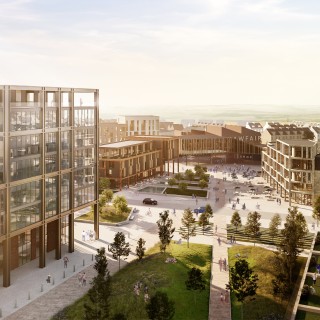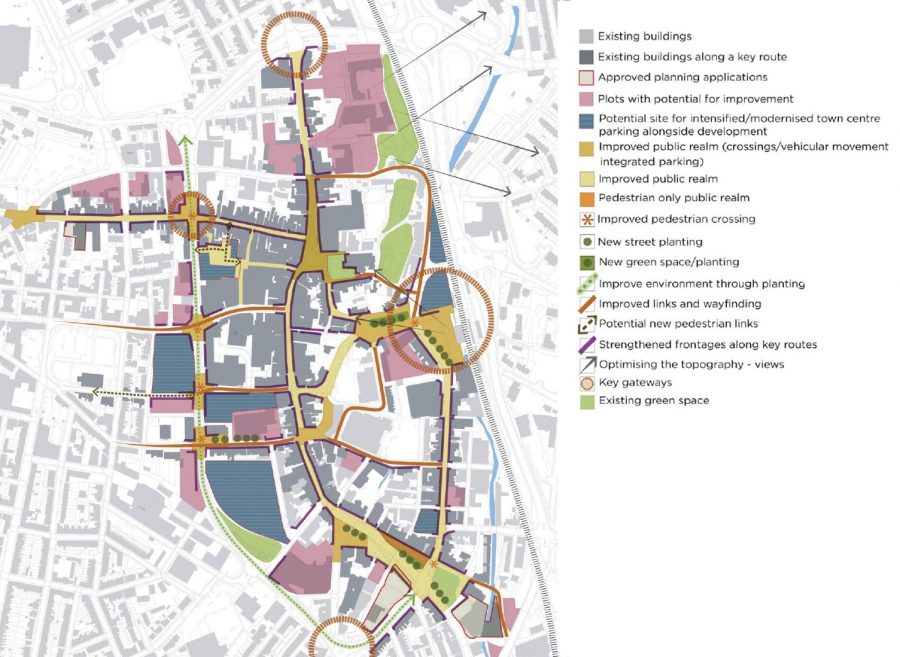
Central Intelligence
- MasterplanningOver the past year it seems the only story able to break through wall-to-wall Brexit coverage has been the growing housing crisis. What is yet to break through is a clear answer on how to tackle the challenge. Political pressures and infrastructure scarcity mean traditional reliance on suburban growth is not always popular or viable and as a result developers and policy makers are looking again at the residential potential of urban areas.

It is clear that our town centres need to play a bigger role in supporting the growth and prosperity of the North West. This comes at a time when the established thinking around the retail role of our centres in being shaken by changes to shopping and leisure habits and public services are consolidating and seeking efficiencies.
It is against this backdrop that the region’s Metro Mayors, Steve Rotheram and Andy Burnham, have been calling for imaginative rethinking of town centres; looking to turn these challenges into an opportunity for positive local change.
With a partnership approach increased public sector support for town centres can: set the conditions for increased private sector investment; establish a mix of uses and services that can attract people; and accommodate the needs of a growing population. From our work in places like Salford and Stockport, we know there is an appetite from developers and local authorities to take up the challenge.
The land that time forgot
Development land is scarce, particularly in sustainable locations, well served by amenities and infrastructure. As Liverpool and Manchester’s Combined Authorities draft City Region spatial strategies and other cities and towns review local plans, town centre sites are being reconsidered as vital brownfield land assets.
Across the North West many of our town and regional city centres have missed successive waves of investment, and seen their status fall relative to regenerating metropolitan centres.
More to life than shopping
In an effort to maintain and strengthen their retail core many towns sought to shoehorn larger format retail and leisure schemes, deemed essential by modern occupiers, into finer-grained and sometimes historic settings. Results have been mixed with large schemes taking a long time to come forward and a number stalling in the process. Many that were completed have found take-up slow.
In the context of changing shopping patterns, accelerated by the internet, many high street mainstays are contracting leaving a range of inflexible units lying vacant with little ongoing demand. These large vacancies, even in modern developments, can blight centres and undermine the attractiveness and viability of the surrounding area.
As retail activity retreats the lack of diversity in some centres is becoming increasingly exposed affecting their value to the local communities that use them and of course to investment funds and centre owners.
A new urban dynamic
Thankfully the region’s modern independent food and drink and retail activity is thriving. According to data from online retailer OnBuy, the North West had the highest rate of independent store openings in the UK in 2017. At the same time shifts in office structures and working patterns are seeing more interest in flexible, local work space. Indeed, the nature of grade A office space is changing in response to occupier expectations, moving closer to the characterful spaces and flexible working environments that were previously the domain of creatives in converted industrial space.
The people occupying or visiting these spaces are also changing how they travel. Increasing numbers are taking up cycling and public transport in reaction to increasing awareness of the financial and environmental costs of car travel and a desire to make healthier lifestyle choices. Given the physical impact and cost of access and parking infrastructure this has to represent a major opportunity in the redesign of our centres.
In Macclesfield we are preparing a framework that, amongst other things, rethinks the balance of movement, moving away from offering maximum convenience for motorists to an environment that makes a positive impact on all visitors. Welcoming spaces and comfortable streets can also encourage the expansion of successful events like the Treacle Market; enhancing the cultural offer, attracting new visitors and supporting independent traders.

Optimising value
Our approach to centres must evolve in response to this new dynamic, particularly moving away from a zonal approach to planning which delivered many of our more sterile urban environments of the last 50 years. The real value of land in our town centres and around transport hubs has always been about more than its physical extent or use class. The ability to build at higher densities, lower parking ratios and as part of a mix of uses, opens up a range of possibilities difficult to achieve in more suburban locations.
To develop these sites for higher density and impact does not necessarily mean to build high rise. Successful design of urban environments involves careful blending of uses and heights, integration of transport to encourage footfall as well as intelligent shaping and maintenance of public spaces that encourage people to linger and return.
Our work for a developer consortium at Shawfair, near Edinburgh, seeks to learn from this, establishing a new town centre as part of a 4,000 home new settlement. The masterplan sets up relationships between education, health care, workspace, food and drink and higher density living to create an active urban environment that captures the benefit of a new station and rail links to Edinburgh and the Borders.
New markets and models of delivery
The mixed-use blocks that support vibrant centres seem effortless in a European context but are all too rare in our modern development. Thankfully a diversifying development scene is emerging with new market entrants, methods of construction and models of delivery.
A reinvigorated Homes England combined with changes allowing local authorities to invest in housing, could support a more interventionist approach from the public sector. Evolving social housing providers are increasingly pursuing more mixed tenure developments on sites that fail to appeal to more traditional developers.
In central Preston we are masterplanning for a range of tenures on just such a site, blending family housing with apartments in a medium-rise format. Critically this is set within a high-quality public realm, designed to allow for critical aspects of privacy and security, balanced with social spaces and opportunity for play; creating a more attractive place to be on many levels.
We are also seeing an increase in interest in urban living from a wider range of people. Making our urban areas attractive to families has long been a target and progress is being made but this is now backed up by PRS accommodation that appeals to professionals old and young as well as assisted living and other new typologies for more mature residents.
The successful centres of the future will blend these different formats and harness this diversity to form sustainable urban communities.
Creating the right environments
Over the last two years we have undertaken masterplan studies for central sites and town centres in Merseyside, Greater Manchester, Cumbria, Lancashire and Cheshire, on behalf of public and private sector clients. We love working in these important places as there is often fantastic latent potential, fascinating technical challenges, and of course a huge amount of pride and attachment from local communities.
These projects all have in common the desire to see centres ‘work harder’; delivering more housing across a broader range of typologies, enhancing the environment, and reshaping a retail and service offer to meet future needs.
The key is to go beyond the remit of traditional design disciplines to carefully shape whole environments that can unlock town centres’ potential. In this way we can help to make the most of brownfield redevelopment, reinvigorate urban areas, create more sustainable suburbs and make places to be proud of in the process.
This article first appeared in Place North West.